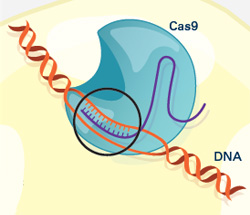The CRISPR gene-editing tool was recognized today by Science magazine as its “breakthrough of the year.” We support a number of researchers working in this exciting area and have featured it on this blog. To learn more about this exceptionally promising new method, see below for our illustrated explanation of the CRISPR system and its possible applications.
How the CRISPR System Works

The CRISPR system has two components joined together: a finely tuned targeting device (a small strand of RNA programmed to look for a specific DNA sequence) and a strong cutting device (an enzyme called Cas9 that can cut through a double strand of DNA).

Once inside a cell, the CRISPR system locates the DNA it is programmed to find. The CRISPR seeking device recognizes and binds to the target DNA (circled, black).

The Cas9 enzyme cuts both strands of the DNA.

Researchers can insert into the cell new sections of DNA. The cell automatically incorporates the new DNA into the gap when it repairs the broken DNA.

CRISPR has many possible uses, including:
- Insert a new gene so the organism produces useful medicines.
- Help treat genetic diseases.
- Create tailor-made organisms to study human diseases.
- Help produce replacements for damaged or diseased tissues and organs.







Emily Carlson:
Nos congratulamos, y ofrecemos nuestras oraciones para que sean bendecidos los investigadores que trabajan en esta área emocionante que han conseguido este Gran Avance del Año.
Pido por favor información acerca de este método nuevo excepcionalmente prometedor, u otro vigente, si también puede tener o tiene como aplicación al Cavum Septum Pellucidum y la Ezquizofrenia.
Muy agradecido por su información.
Jorge Guzmán
This is fantastic. I hope it will work for chronic granulomatous disease (CGD). We (the CGD Association) can give small grants for CRISPR research.
The discovery of the ‘CRISPER EDITING TOOL’ is fantastic. This will open a new horizon in the field of ‘ OMIC ‘ disorders.